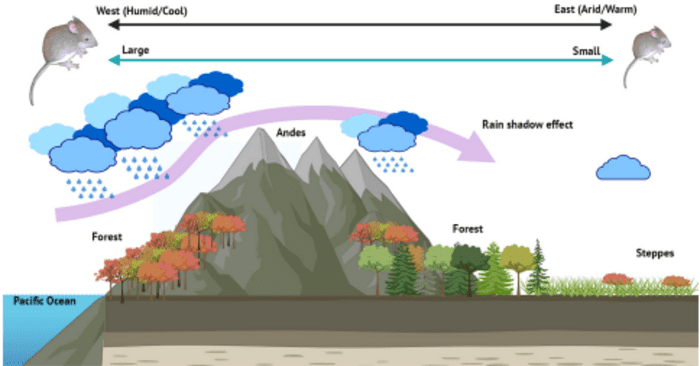When researchers studied the skulls of 450 shaggy soft-haired mice (Abrothrix hirta) they thought those from the western side were so much bigger that they probably represented different species. Instead, what they found was a likely new biological law.
Carl Bergmann came up with the observation that animals at higher latitudes are larger than those in equatorial regions. If you’re thinking; “What about very tropical elephants and hippopotami?” you’re not wrong, but Bergmann was considering differences within a species, not between them. Nearly two centuries of research has confirmed what is now known as Bermann’s Rule, and we also know the reason. Smaller animals have more surface area to body mass, meaning they lose energy faster – beneficial where it’s hot and a hindrance in cold climates.
The Field Museum’s Dr Noé de la Sancha and co-authors think they may have come up with a new version, applying not to temperature but rainfall, which they have presented in the Journal of Biogeography.
“There are a bunch of ecogeographic rules that scientists use to explain trends that we see again and again in nature,” de la Sancha said in a statement. “With this paper, I think we might have found a new one: the rain shadow effect can cause changes of size and shape in mammals.”
Rain shadows occur when the winds over mountains come consistently from one direction, picking up plenty of water vapor from oceans or rainforests. Mountain slopes push clouds upwards into colder air, causing them to dump most of the water they are carrying. Once over the mountains, there is very little water vapor left. Consequently, the windward side of the mountains can be very wet, while the other side is dry.
The southern Andes provide a classic example of the rain shadow effect, with higher rainfall on the west and lower in the east. The Atacama Desert lies in a dual rain shadow, with mountain ranges on either side capturing winds in either direction. Image Credit: Teta et al, 2022
This is such a widespread geographical feature it’s often taught in high school, but the effect on the slopes’ inhabitants is much less understood.
First author Dr Pablo Teta of the Museo Argentino de Ciencias Naturales wasn’t seeking to uncover broad biogeographic principle; he was just trying to investigate some overlooked mice. “They’re very cute little buggers, they have soft white bellies,” de la Sancha said. “They live in the mountains, which makes them unique, but they’re also found in lower elevations. Overall, they’re not very well-studied.”
Teta noticed the unusual spread in the sizes of 450 mouse skulls, but mitochondrial DNA indicated the presence of multiple species was unlikely. Despite being collected over 19 degrees of latitude, Bergmann’s rule had only a minor effect on size. The authors tried investigating a range of other variables from the locations the skulls were collected at; easily the most important was longitude.
While teaching an ecology class that covered the rain shadow effect, de la Sancha remembered the Andes provide a particularly clear example, and realized the bigger mice were located on the rainy side. “On some mountains, the difference is extreme. One face can be a tropical rainforest, and the other side will be almost desert-like,” de la Sancha said.
Further investigation confirmed his suspicion was an application of the “resource rule”, which says that members of a species grow bigger where food and other resources are more abundant. More rain on the west side of the mountains means more plant life, which in turn means bigger mice. Put like this it might seem obvious, but according to de la Sancha, no one has ever found a connection between rain shadows and mammal size before.
If the mice turn out to be the only species where rain shadows have this effect the team will have discovered a curiosity, but if further study produces a pattern this could one day be considered a rule that ranks with Bergmann’s. After all, the paper notes; “Mountains cover approximately 22% of the planet’s terrestrial surface,” so there is a lot of potentially affected territory.
These days, all geography exists in a different shadow, however; that of climate change. No one knows what’s in store for the cute mice, but rain patterns are shifting, and the mice may suffer. That’s in addition to the universal alpine threat of being forced higher up slopes by rising temperatures. “At a certain point, you run out of mountain,” de la Sancha said.
The Andes are high enough to give the mice a fair amount of room, but without more study we won’t know if they’re yet another threatened species.
Source Link: Mice Grow Larger On Mountains' Rainier Side, Revealing A Likely New Law Of Nature
